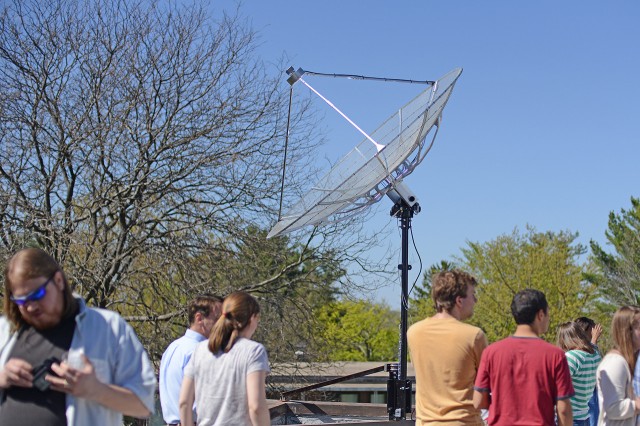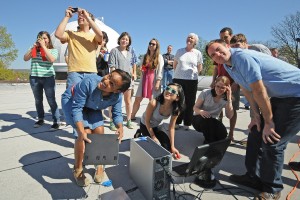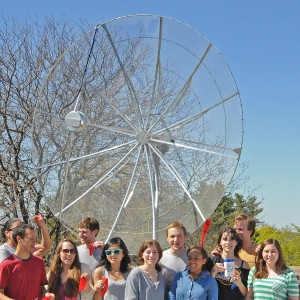Students Construct Radio Telescope for Astronomy Department

(Story contributed by Jim Smith)
When graduate student Amy Steele settled into her seat the first day of an upper-level Radio Astronomy course last January she was anticipating a rigorous four-month exploration of the discipline. The instructor, Meredith Hughes, who had just joined the Astronomy Department as an assistant professor, came with strong credentials in radio astronomy.
Steele was excited. After completing her undergraduate work at Williams College, she had taken four years off to work as the astronomy lab supervisor at the University of Texas at Arlington. Last fall she enrolled as a graduate student at Wesleyan.

“Radio astronomy is super powerful,” she said, “and it’s a very rewarding area to work in. It offers the potential for many discoveries in years to come.”
What neither Steele nor any of her fellow students was expecting was the opportunity to actually construct a radio telescope. But that was the task Hughes laid out for them after she had reviewed the course syllabus. Following design specifications for a small radio telescope (SRT) developed by Alan Rogers at MIT’s Haystack Observatory, the students would not only create a functional radio telescope, they would do so by the end of the semester.
The project was made all the more challenging by the fact that there was no kit for the device. “Haystack used to sell SRT kits,” Hughes explained. “Dozens of them were built and many are still in use. But as electronics improved, the original kits became obsolete. Just last summer Alan Rogers retooled the telescope design and they decided to stop producing kits and just publish the plans.
“Working from plans enhances the value of the learning experience,” she adds. “While many of the components are commercially produced, some parts have to be fabricated or assembled. For example, the main light-gathering component is a piece of copper tape wrapped around a foam rod, bolted inside a metal cake pan. It’s both challenging and fun for students.”
Hughes divided her class into three teams, each of which was responsible for a different part of the telescope. Each team would work separately, acquiring and assembling the components for its part of the telescope, but they would also interact.

To assist them with the project, the students recruited Mike Koziol, a Wesleyan electronics technician, and Dave and Bruce Strickland, from the university’s machine shop. Steele’s team was responsible for creating the telescope’s dish – fabricated from metal mesh upon a hoop-like frame – and attaching it to the rotor, the motorized arm that can position the dish to face any part of the sky.
Laiya Ackman, a Wesleyan sophomore, volunteered to help with the project. Though she was not a member of Hughes’ class, she was drawn by the learning opportunity. And alumnus Jon Wallace ’92 also pitched in to help. A science and mathematics teacher in the Meriden Public Schools, Wallace is a long-time member of the Society of Amateur Radio Astronomers (SARA) and has built several radio telescopes on his own. He got in touch with Hughes and offered to mentor the student groups after he read about the plan to build the SRT.
“One of the goals of SARA is to help people who are learning about radio astronomy,” said Wallace, who spent 10 years building his first radio telescope, a sometimes frustrating process during which, he says, he learned a lot about the technology. “It was fun to be involved in this project.”
Wesleyan is the first university to assemble an SRT from the upgraded system plans published by Haystack. The creation of the device speaks to the importance of the technology in modern astronomy. Of the 10 astronomers who have received Nobel prizes in astronomy, six used radio telescopes in their research. Quasars, pulsars, and the afterglow of the Big Bang have all been discoveries of radio astronomy.
Radio telescopes are highly complementary to optical telescopes. Able to see through cloud cover, they are not limited by weather. The radio sky is also quite different from the optical sky: Stars are very faint, but the remnants of exploding stars and distant supermassive black holes shine brightly.
Wesleyan’s SRT debuted on May 1, a warm spring day, when Hughes and her students held a “first light” party. Once all of the components were assembled on the observatory roof, the team successfully used the new device to detect the sun, proof that the telescope actually worked. Going forward it will allow Wesleyan students to detect more remote radio sources, map galactic rotation and conduct other kinds of astronomical research. It will be an essential tool in the university’s astronomy courses.
“Building it was a great learning exercise,” Steele said. “It was especially exciting to see the dish hoisted to the observatory roof and fitted into place, and then to see the telescope actually work. We were all really proud of our telescope.”

